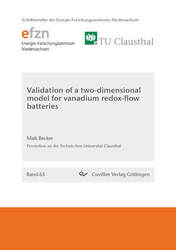| Fachbereiche | |
|---|---|
| Buchreihen (96) |
1378
|
| Nachhaltigkeit |
3
|
| Gesundheitswesen |
1
|
| Geisteswissenschaften |
2364
|
| Naturwissenschaften |
5406
|
| Mathematik | 229 |
| Informatik | 319 |
| Physik | 980 |
| Chemie | 1363 |
| Geowissenschaften | 131 |
| Humanmedizin | 243 |
| Zahn-, Mund- und Kieferheilkunde | 10 |
| Veterinärmedizin | 108 |
| Pharmazie | 147 |
| Biologie | 835 |
| Biochemie, Molekularbiologie, Gentechnologie | 121 |
| Biophysik | 25 |
| Ernährungs- und Haushaltswissenschaften | 45 |
| Land- und Agrarwissenschaften | 1004 |
| Forstwissenschaften | 201 |
| Gartenbauwissenschaft | 20 |
| Umweltforschung, Ökologie und Landespflege | 148 |
| Ingenieurwissenschaften |
1793
|
| Allgemein |
98
|
|
Leitlinien Unfallchirurgie
5. Auflage bestellen |
|
Erweiterte Suche
Validation of a two-dimensional model for vanadium redox-flow batteries (Band 65)
Maik Becker (Autor)Vorschau
Inhaltsverzeichnis, PDF (540 KB)
Leseprobe, PDF (760 KB)
Redox-Flow batteries can play a crucial role in the future electricity supply in order to balance the time lag between the generation of electrical energy from photovoltaics or wind power and the demand for electrical energy. However, to deploy the technology on a large scale, significant cost reductions are required. A thorough knowledge of the reactions and processes taking place within a redox-flow battery is very helpful for this task and this knowledge can be significantly improved by using a suitable mathematical model to describe the processes in a single cell of a redox-flow battery. Nevertheless, this requires a valid model that has been compared with experimental data and that can reproduce these data plausibly and validly.
In this thesis, the validation of a two-dimensional model for the description of potential and current density distributions in the porous electrodes of a vanadium redox-flow battery is presented, taking into account effects of kinetics and mass transport. Newly developed potential probes are used for in-situ measurement of solid and liquid phase potentials within a single cell of a vanadium redox-flow battery. The description of the measured cell voltage and potential probe signals by the model reveals a good congruence between the model and the experimental data, so the model can be regarded as valid. Additional suggestions for improvements of the model and the implementation of further models describing membrane crossover effects or electrolyte properties are given.
| ISBN-13 (Printausgabe) | 9783736972100 |
| ISBN-13 (E-Book) | 9783736962101 |
| Buchendformat | A5 |
| Sprache | Englisch |
| Seitenanzahl | 150 |
| Umschlagkaschierung | matt |
| Auflage | 1. |
| Buchreihe | Schriftenreihe des Energie-Forschungszentrums Niedersachsen (EFZN) |
| Band | 65 |
| Erscheinungsort | Göttingen |
| Promotionsort | TU Clausthal |
| Erscheinungsdatum | 11.05.2020 |
| Allgemeine Einordnung | Dissertation |
| Fachbereiche |
Technische Chemie und Chemieingenieurwesen
Maschinenbau und Verfahrenstechnik Energietechnik |
| Schlagwörter | redox flow battery, redox-flow battery, vanadium, mathematical model, 2D model, two dimensional model, validation, potential probes, pseudo reference electrodes, current density distribution, electrochemical kinetics, kinetics, exchange current density, reaction rate constant, charge transfer resistance, charge transfer coefficient, tafel slope, carbon felt, membrane resistance, impedance spectroscopy, Nyquist plot, carbon felt resistance, polarization curve, solid phase probe, liquid phase probe, redox potential, mass transport, mass transfer coefficient, Sherwood number, Reynolds number, mass transport correlation, electrolyte properties, diffusion coefficient, Redox Fluss Batterie, Redox-Flow Batterie, Vanadium, Mathematisches Model, 2D Model, zweidimensionales Model, Validierung, Potentialmesssonde, Pseudoreferenzelektrode, Stromdichteverteilung, elektrochemische Kinetik, Kinetik, Austauschstromdichte, Reaktionsgeschwindigkeitskonstante, Ladungsübertragungswiderstand, Ladungsübertragungskoeffizient, Tafelsteigung, Kohlenstofffilz, Membranwiderstand, Impedanzspektroskopie, Nyquist-Diagramm, Kohlenstofffilzwiderstand, Polarisationskurve, UI-Kennlinie, Festphasenpotentialmesssonde, Flüssigphasenpotentialmesssonde, Redox-Potential, Stofftransport, Stofftransportkoeffizient, Sherwoodzahl, Reynoldszahl, Stofftransportkorrelation, Elektrolyteigenschaften, Diffusionskoeffizient |








